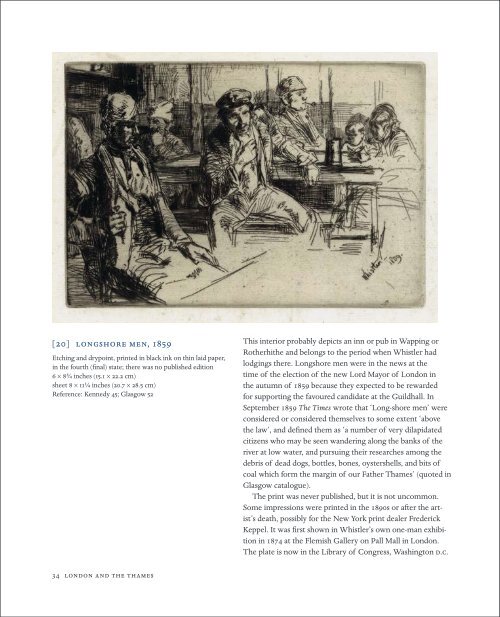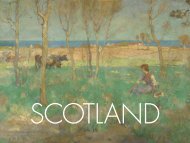Create successful ePaper yourself
Turn your PDF publications into a flip-book with our unique Google optimized e-Paper software.
[20] Longshore Men, 1859<br />
Etching and drypoint, printed in black ink on thin laid paper,<br />
in the fourth (final) state; there was no published edition<br />
6 x 8 3/4 inches (15.1 x 22.2 cm)<br />
sheet 8 x 11 1/4 inches (20.7 x 28.5 cm)<br />
Reference: Kennedy 45; Glasgow 52<br />
This interior probably depicts an inn or pub in Wapping or<br />
Rotherhithe and belongs to the period when Whistler had<br />
lodgings there. Longshore men were in the news at the<br />
time of the election of the new Lord Mayor of London in<br />
the autumn of 1859 because they expected to be rewarded<br />
for supporting the favoured candidate at the Guildhall. In<br />
September 1859 The Times wrote that ‘Long-shore men’ were<br />
considered or considered themselves to some extent ‘above<br />
the law’, and defined them as ‘a number of very dilapidated<br />
citizens who may be seen wandering along the banks of the<br />
river at low water, and pursuing their researches among the<br />
debris of dead dogs, bottles, bones, oystershells, and bits of<br />
coal which form the margin of our Father Thames’ (quoted in<br />
Glasgow catalogue).<br />
The print was never published, but it is not uncommon.<br />
Some impressions were printed in the 1890s or after the artist’s<br />
death, possibly for the New York print dealer Frederick<br />
Keppel. It was first shown in Whistler’s own one-man exhibition<br />
in 1874 at the Flemish Gallery on Pall Mall in London.<br />
The plate is now in the Library of Congress, Washington D.C.<br />
[21] Black Lion Wharf, 1859<br />
Etching and drypoint, printed in black ink on laid paper, an<br />
impression in the fourth (final) state, aside from the edition<br />
published in A Series of Sixteen Etchings of Scenes on the Thames and<br />
Other Subjects (the Thames Set)<br />
6 x 8 7/8 inches (15 x 22.5 cm) sheet 8 x 13 inches (20.3 x 33 cm)<br />
Provenance: Henri Beraldi<br />
Literature: Kennedy 42; Glasgow 54<br />
An impression of Black Lion Wharf was exhibited at the<br />
Royal Academy of Arts in 1860 (902) and it is thus one of<br />
the first of the Thames etchings to be shown in public.<br />
Its importance to the artist may be suggested by its<br />
inclusion, framed on the wall, in his painting Arrangement<br />
in Grey and Black: Portrait of the Painter’s Mother (1871;<br />
Musée d’Orsay, Paris), perhaps Whistler’s best-known<br />
work.<br />
Black Lion Wharf was on the north bank of the<br />
Thames near St Katharine’s Dock, just below the Tower<br />
of London. Katharine Lochnan has suggested that it was<br />
drawn from the Horsleydown New Stairs on the South<br />
Bank, and that, uniquely among the Thames subjects,<br />
it was drawn in reverse so that the view appears the right<br />
way round in the etching.<br />
The print was exhibited in The Works of James Whistler<br />
– Etchings and Dry Points at E. Thomas’s print shop at<br />
39 Old Bond Street in 1861, and then at the Société<br />
Nationale des Beaux-Arts in Paris in 1862. The subject<br />
was published in the Thames Set; no.1. The plate was<br />
sold by F. Keppel & Co. to Charles Lang Freer in 1896<br />
and is now in the Freer Gallery of Art.<br />
34 london and the thames james mcneill whistler: prints 35



